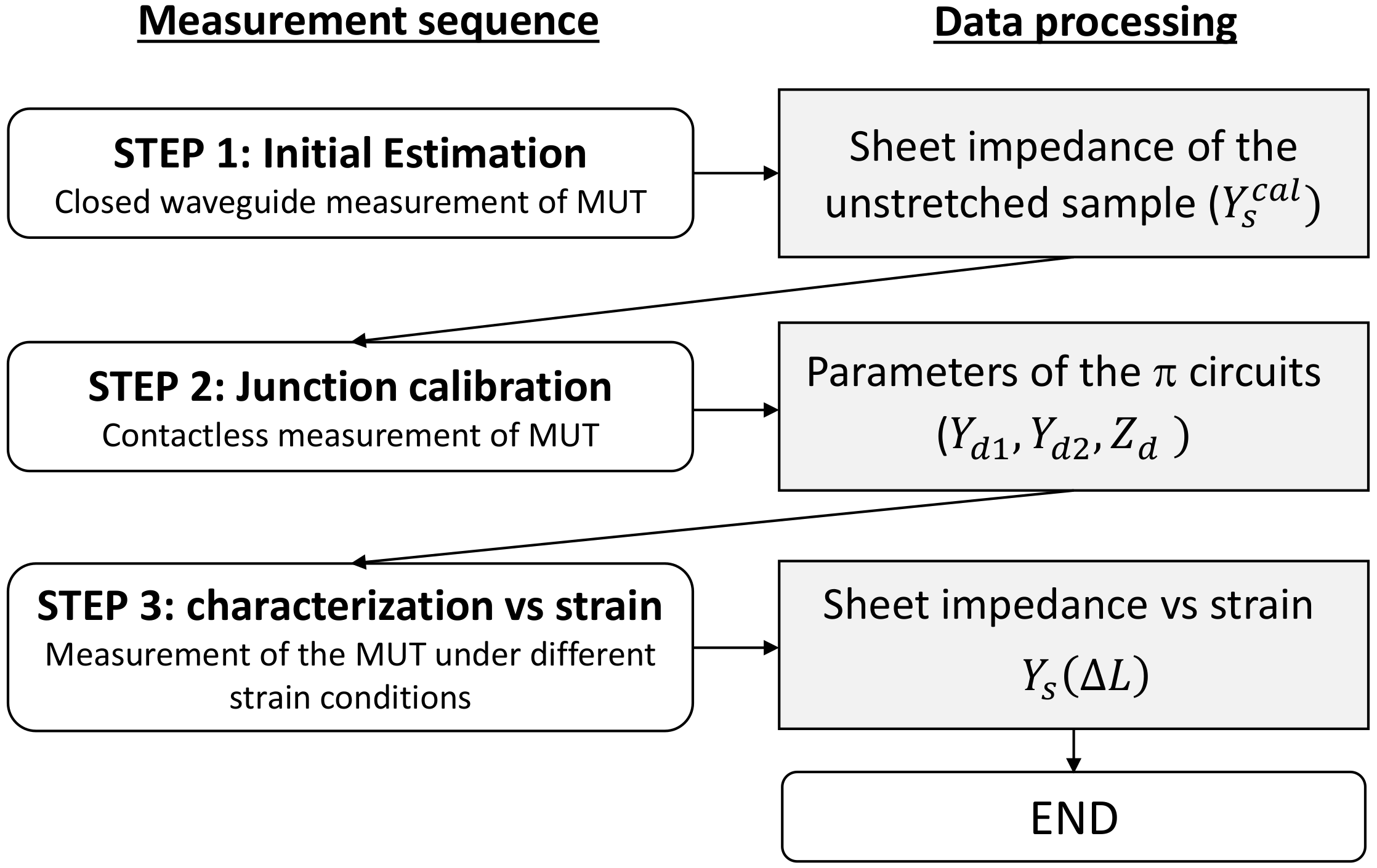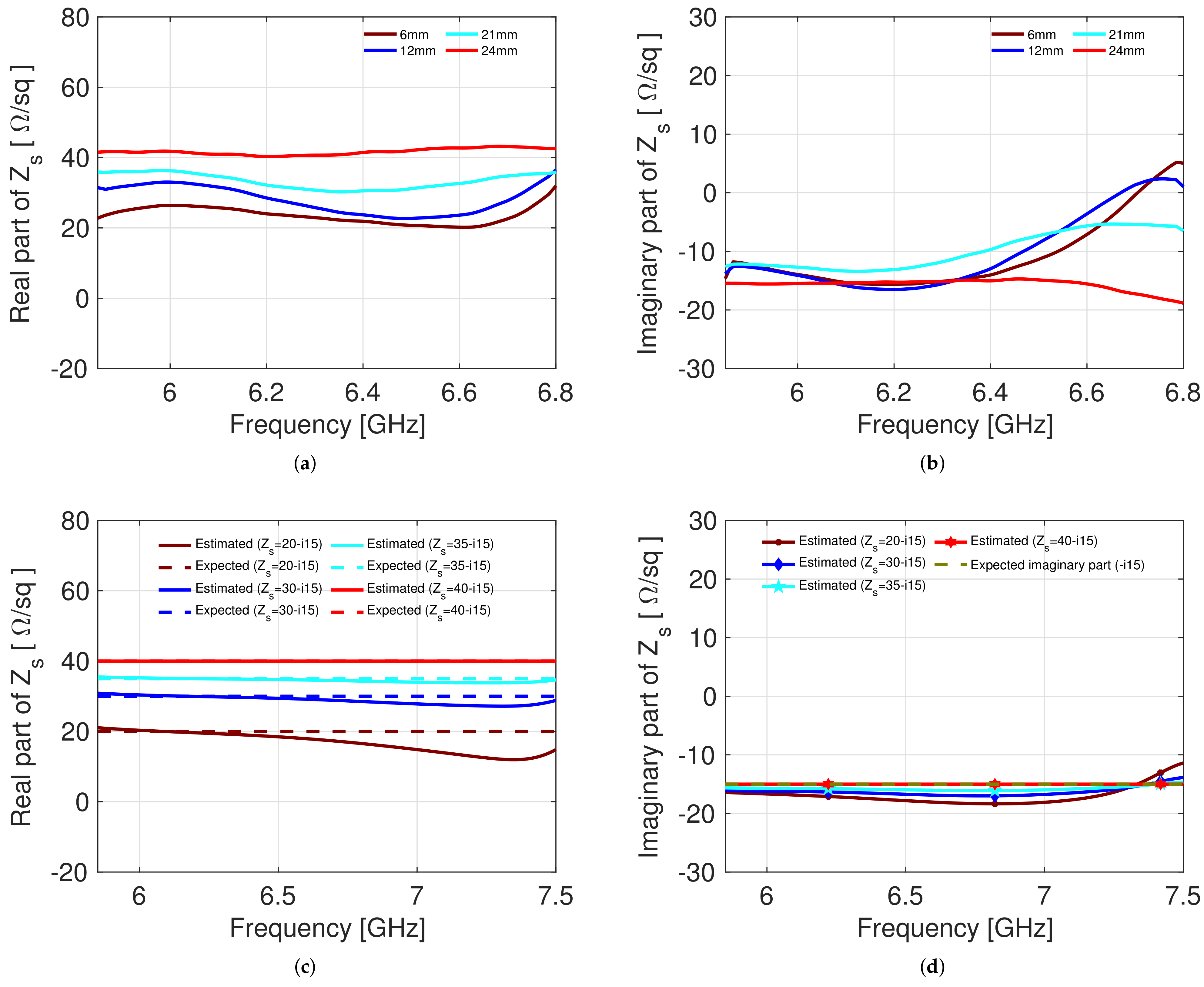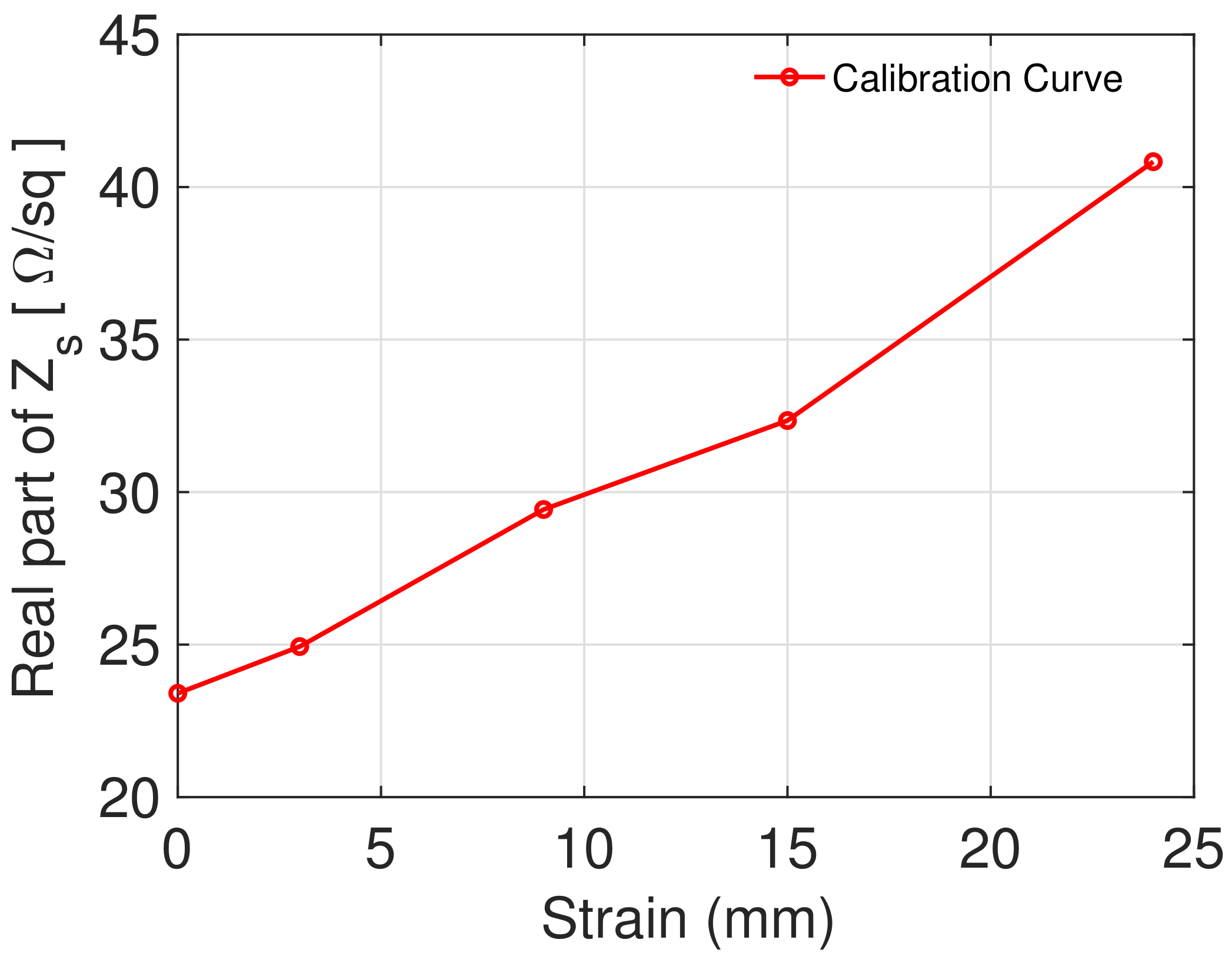Contactless Waveguide Characterization of Piezoresistive Materials for Wireless Strain Sensors
Abstract
:1. Introduction
2. Characterization Procedure
3. Results
3.1. Numerical Results
3.2. Experimental Results
4. Conclusions
Author Contributions
Funding
Institutional Review Board Statement
Informed Consent Statement
Data Availability Statement
Conflicts of Interest
References
- Teyeme, Y.; Malengier, B.; Tesfaye, T.; Van Langenhove, L. A Fabric-Based Textile Stretch Sensor for Optimized Measurement of Strain in Clothing. Sensors 2020, 20, 7323. [Google Scholar] [CrossRef] [PubMed]
- Zhao, J.; Zhang, G.Y.; Shi, D.X. Review of graphene-based strain sensors. Chin. Phys. B 2013, 22, 057701. [Google Scholar] [CrossRef]
- Kang, I.; Schulz, M.J.; Kim, J.H.; Shanov, V.; Shi, D. A carbon nanotube strain sensor for structural health monitoring. Smart Mater. Struct. 2006, 15, 737. [Google Scholar] [CrossRef]
- Chuang, J.; Thomson, D.; Bridges, G. Embeddable wireless strain sensor based on resonant RF cavities. Rev. Sci. Instruments 2005, 76, 094703. [Google Scholar] [CrossRef]
- Min, S.H.; Kim, H.J.; Quan, Y.J.; Kim, H.S.; Lyu, J.H.; Lee, G.Y.; Ahn, S.H. Stretchable chipless RFID multi-strain sensors using direct printing of aerosolised nanocomposite. Sens. Actuators A Phys. 2020, 313, 112224. [Google Scholar] [CrossRef]
- Costa, F.; Genovesi, S.; Borgese, M.; Michel, A.; Dicandia, F.A.; Manara, G. A review of RFID sensors, the new frontier of internet of things. Sensors 2021, 21, 3138. [Google Scholar] [CrossRef] [PubMed]
- Jansen, K. Performance evaluation of knitted and stitched textile strain sensors. Sensors 2020, 20, 7236. [Google Scholar] [CrossRef] [PubMed]
- Costa, F. Surface impedance measurement of resistive coatings at microwave frequencies. IEEE Trans. Instrum. Meas. 2012, 62, 432–437. [Google Scholar] [CrossRef]
- Pauw, L. A method of measuring specific resistivity and Hall effect of discs of arbitrary shape. Philips Res. Rep. 1958, 13, 1–9. [Google Scholar]
- Costa, F.; Borgese, M.; Degiorgi, M.; Monorchio, A. Electromagnetic characterisation of materials by using transmission/reflection (T/R) devices. Electronics 2017, 6, 95. [Google Scholar] [CrossRef] [Green Version]
- Krupka, J. Contactless methods of conductivity and sheet resistance measurement for semiconductors, conductors and superconductors. Meas. Sci. Technol. 2013, 24, 062001. [Google Scholar] [CrossRef]
- Hernandez, A.; Martin, E.; Margineda, J.; Zamarro, J. Resonant cavities for measuring the surface resistance of metals at X-band frequencies. J. Phys. Sci. Instrum. 1986, 19, 222. [Google Scholar] [CrossRef]
- Krupka, J.; Klinger, M.; Kuhn, M.; Baryanyak, A.; Stiller, M.; Hinken, J.; Modelski, J. Surface resistance measurements of HTS films by means of sapphire dielectric resonators. IEEE Trans. Appl. Supercond. 1993, 3, 3043–3048. [Google Scholar] [CrossRef]
- Krupka, J.; Strupinski, W. Measurements of the sheet resistance and conductivity of thin epitaxial graphene and SiC films. Appl. Phys. Lett. 2010, 96, 082101. [Google Scholar] [CrossRef]
- Booth, J.; Wu, D.H.; Anlage, S.M. A broadband method for the measurement of the surface impedance of thin films at microwave frequencies. Rev. Sci. Instrum. 1994, 65, 2082–2090. [Google Scholar] [CrossRef]
- Ye, M.; Tariq, R.U.; Zhao, X.L.; Li, W.D.; He, Y.N. Contactless Measurement of Sheet Resistance of Nanomaterial Using Waveguide Reflection Method. Materials 2020, 13, 5240. [Google Scholar] [CrossRef] [PubMed]
- Feng, Y.R.; Wei, X.C.; Yi, D.; Gao, R.X.K. An enhanced one-port waveguide method for sheet resistance extraction. IEEE Trans. Electromagn. Compat. 2019, 62, 1822–1829. [Google Scholar]
- Lee, M.J.; Collier, R. The sheet resistance of thin metallic films and stripes at both DC and 130 GHz. Microelectron. Eng. 2004, 73, 916–919. [Google Scholar] [CrossRef]
- Wang, X.C.; Díaz-Rubio, A.; Tretyakov, S.A. An accurate method for measuring the sheet impedance of thin conductive films at microwave and millimeter-wave frequencies. IEEE Trans. Microw. Theory Tech. 2017, 65, 5009–5018. [Google Scholar] [CrossRef] [Green Version]
- Rodini, S.; Genovesi, S.; Manara, G.; Costa, F. A contactless measurement of the surface impedance of a thin sheet of material. In Proceedings of the 2021 XXXIVth General Assembly and Scientific Symposium of the International Union of Radio Science (URSI GASS), Montreal, QC, Canada, 19–26 August 2017; pp. 1–4. [Google Scholar]
- Rodini, S.; Genovesi, S.; Manara, G.; Costa, F. EBG waveguides for contactless surface impedance measurements. J. Phys. Conf. Ser. 2021, 2015, 012030. [Google Scholar] [CrossRef]
- Rodini, S.; Genovesi, S.; Manara, G.; Costa, F. A novel approach for the contactless estimation of the surface impedance. In Proceedings of the 2021 IEEE International Symposium on Antennas and Propagation and USNC-URSI Radio Science Meeting (APS/URSI), Marina Bay Sands, Singapore, 10–16 July 2021; pp. 857–858. [Google Scholar]
- Shieldex® Med-Tex P130. Available online: https://www.shieldex.de/products/shieldex-med-tex-p130/ (accessed on 16 May 2022).








Publisher’s Note: MDPI stays neutral with regard to jurisdictional claims in published maps and institutional affiliations. |
© 2022 by the authors. Licensee MDPI, Basel, Switzerland. This article is an open access article distributed under the terms and conditions of the Creative Commons Attribution (CC BY) license (https://creativecommons.org/licenses/by/4.0/).
Share and Cite
Rodini, S.; Genovesi, S.; Manara, G.; Costa, F. Contactless Waveguide Characterization of Piezoresistive Materials for Wireless Strain Sensors. Sensors 2022, 22, 4085. https://doi.org/10.3390/s22114085
Rodini S, Genovesi S, Manara G, Costa F. Contactless Waveguide Characterization of Piezoresistive Materials for Wireless Strain Sensors. Sensors. 2022; 22(11):4085. https://doi.org/10.3390/s22114085
Chicago/Turabian StyleRodini, Sandra, Simone Genovesi, Giuliano Manara, and Filippo Costa. 2022. "Contactless Waveguide Characterization of Piezoresistive Materials for Wireless Strain Sensors" Sensors 22, no. 11: 4085. https://doi.org/10.3390/s22114085





